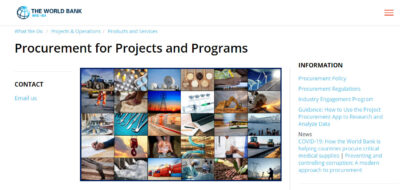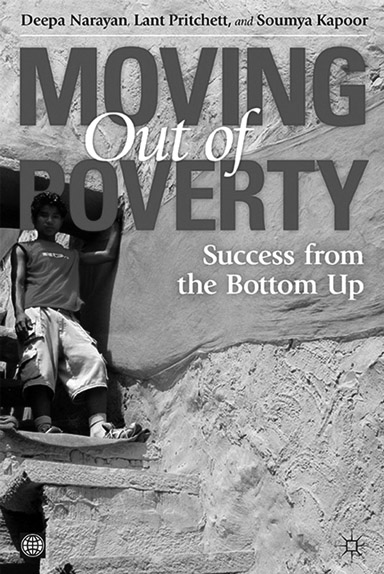Deepa Narayan, Lant Pritchett & Soumya Kapoor. 428 pages. A co-publication of the World Bank and Pelgrave MacMillan, 2009.
Moving Out of Poverty is an engaging read and will be of interest to the academic, the development practitioner, the policy maker and indeed anyone who has an interest in the poverty eradication and economic development. The book’s observations and findings are based on first hand narratives and life stories as told by more than 60,000 people, from 500 communities across 21 regions in 15 countries – a truly massive undertaking. It provides an inside look at the lives of the poor, the near poor and even the not so poor. It identifies, from their varied perspectives, the challenges, constraints and obstacles to moving out of poverty and the sometimes more challenging task of staying out of poverty. It effectively consolidates these stories into discussions around the determinants of poverty and what is important at the individual and household level in the fight to reduce poverty.
Regardless of one’s experience in economics, development, sociology or other social science, the book is certain to change one’s views about the nature of poverty. By starting at the ground floor, in talking to thousands and thousands of people, a level of clarity and insight into the condition of poverty is achieved that has rarely been attained elsewhere. And the authors emphasize that poverty is a condition. Throughout the book, the poor themselves are clear in describing poverty as a condition that they temporarily find themselves in; it is not perceived as permanent, or something that defines them. One is not a “poor person”, one is simply presently experiencing poverty.
One of the first characteristics of poverty that becomes clearly evident is that it is anything but static. In constantly dealing with aggregate poverty statistics that remain frustratingly stubborn, as in the failure of poverty rates in many African countries to budge downward, we easily fall into the trap of thinking that things are stagnant on the poverty front, that no one is escaping poverty, that there is no movement.
The authors dispel this notion. In reality, even in those economies with little or no change in aggregate poverty indicators, people are frequently and routinely escaping poverty. Unfortunately, in these environments just as many people are sliding into poverty. The authors provide insight in highlighting the factors that contribute to this continual movement out of poverty, and those that can lead others into poverty. While each story is unique, there are threads of commonality.
Another factor that becomes evident is that community matters. “Local” is more important than “national.” Again, as development practitioners and policy makers we have a tendency to think nationally. The poor far more frequently identify local factors as major determinants of their condition – and their ability to change their condition – than national policies, regulations or services.
The authors find that there is far more variation between communities in those moving out of poverty than at the national level. 75% of the variation in upward movement depends on the community, while 25% is attributed to the region or country. As such, local context matters, and solutions need to go far below the national level, targeting local prosperity and expanding local opportunity, through local roads, local infrastructure, local markets, local government attentiveness and capacity, and the identification of local change agents.
In the end, the authors remain non-prescriptive, recognizing the amazing diversity inherent in the thousands of stories. Nonetheless, they effectively relate their findings to four current approaches to poverty and to three broad principles that they believe should inform poverty reduction efforts, summarized as follows:
1) Actions should seek to expand the scope for people in poverty to use their agency. We need to change our view from looking at the poor as people with “needs” to be filled, to recognizing that the poor, like all of us, have dreams, ambitions, plans, skills, ideas and preferences. We need to help the poor exercise their agency, individually and collectively.
2) Actions should seek to transform markets into ones that poor people can access and participate in fairly. The poor see market-based initiative as a means to advancement, but often do not enjoy equal opportunities in free markets.
3) Well functioning local democracies can help people move out of poverty. Governance at the local level is often corrupt, unaccountable and creates opportunities for some, the favoured, while erecting barriers for others. Fair, accountable local democracies and local leaders can do much to liberalize economies and provide opportunities from below.
There is far more to this book than can be conveyed here. Suffice it to say that the authors provide a valuable window into the factors and determinants that enable people to escape from poverty. One cannot help but be moved by the numerous personal battles with poverty and survival that are conveyed throughout the book. It is a clear and poignant reminder of the real people behind the statistics and their determined and at times valiant efforts to build better lives for themselves and their children. In highlighting the obstacles they confront and the platforms that help them in their individual struggles, may we find more effective ways to help. A highly recommended read.



